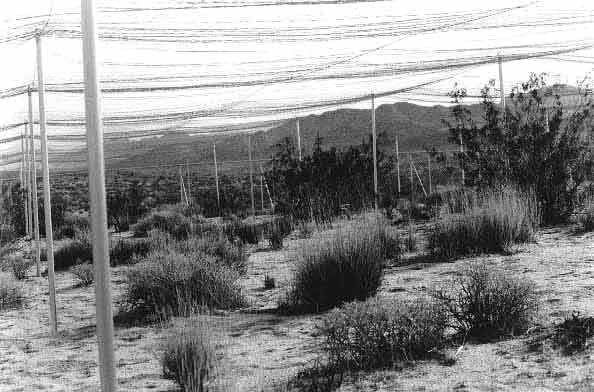Predator-Proof Field Enclosures
for Enhancing Hatching Success and Survivorship
of Juvenile Tortoises: A Critical Evaluation
 The Fort Irwin study site (Enclosure 1) in the central Mojave Desert of California. This enclosure was established to study neonatal and juvenile tortoise biology in neonatal and juvenile tortoise biology in Gopherus agassizii. |
DAVID J. MORAFKA,1 KRISTIN H. BERRY,2
1 Department of Biology, California State University, Dominguez Hills,
Carson, CA 90747-0005, USA
2 U.S. Geological Survey, Biological Resources Division,
6221 Box Springs Blvd., Riverside, CA 92507-0714, USA
ABSTRACT: In situ predator-proof enclosures or pens can provide low-cost technology to conduct research on early life stages of tortoises and improve hatching success and juvenile survivorship of threatened and endangered species without the negative effects commonly experienced with captive-reared tortoises.
In situ experiments with two North American tortoise species, the Bolson tortoise (Gopherus flavomarginatus) and the desert tortoise (G. agassizii), provided valuable insights. The initial work (1983) with G. flavomarginatus at Mapimí, Durango, Mexico was characterized by extensive human manipulation and relatively low survivorship. Eggs were harvested from wild females using injections of oxytocin and were hatched in outdoor solar-powered incubators with a 65–67% success rate. Neonates were transferred to 20, 1 × 3 m wood and adobe pens constructed within an 11 × 13 × 2.5 m outdoor wire enclosure. Each pen held 1–2 neonates, which were provided with water and food. During the three-year trial, survivorship in the nursery was 76% (n = 86). Annual growth rates of juveniles declined from 184.7% (in weight) in the first year to nearly zero in the third year. For the 1983 cohort of neonates, three-year survivorship was 60%.
Building on the experience of the 1983 project, a second, but more passive, program was initiated in 1990 for G. agassizii at Fort Irwin in the Mojave Desert of California, USA. Wild females were temporarily relocated to a 60 × 60 × 2.6 m high fenced enclosure with natural, undisturbed desert vegetation. Females were permitted to range freely and nest, after which most were returned to their home sites. Hatching success was 90–94%. Some neonates constructed their own burrows, while others exploited pre-existing shelters or artificial burrows. No food or water was provided. Most individuals showed continuous growth into the third year. Drought conditions were probably responsible for declines in their growth and weights in the fourth year, and by the end of the fifth year, five (4.5%, n = 110) juveniles had died of starvation and dehydration. Excluding juveniles killed by predators (in a control area and in an exposed section of the enclosure), overall survivorship for the first three and one half years (between 1990 and 1994) was 88%. Despite the losses to drought during the fourth and fifth years, this passive treatment shows greater promise of success. The issue of carrying capacity within an enclosure, however, requires further investigation. Designs for two different field enclosures and alternate treatments are proposed, and recommendations are made for future in situ field programs.
